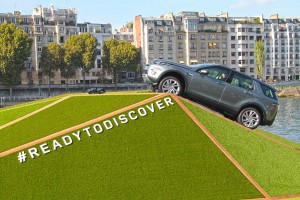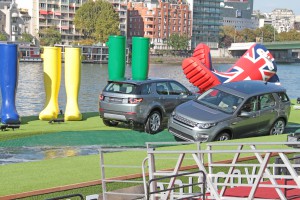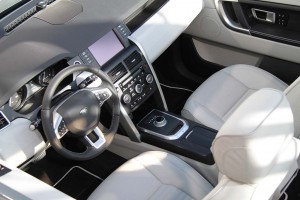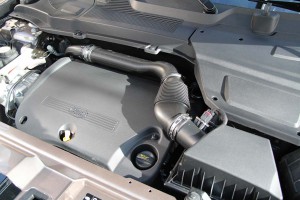Most automakers are content to reveal their new products with the help of a few spotlights, a little music, perhaps even a couple acrobats and entertainers. But Land Rover literally barged in for the 2014 Paris Motor Show, staging a splashy media preview on a Seine riverboat.
One can understand the British maker’s enthusiasm. Land Rover has been gaining significant momentum in recent years with the launch of a series of new products for its Range Rover sub-brand. Now, it’s turning its attention to the Discovery nameplate, and the all-new Discovery Sport model debuting in Paris will become the first in a family of models that will serve as Land Rover’s mid-range line-up.
“We’re looking to how we can stretch the brand,” explained Land Rover design chief Gerry McGovern, stressing that “This is very much a product-led transformation of our business. We’re looking not only to replace existing vehicles but how we can fill the white space” between those older Land Rover models.
Despite some initial media reports, the Discovery Sport is not a replacement for the old Land Rover Freelander model, company officials stressed. Nor is it a remake of the old Discovery. It essentially fills the same niche in the new Discovery “family” that the Evoq has occupied in the Range Rover line.
(Jaguar lays out launch plans, U.S. specs for the new XE sports sedan. Click Here for a closer look.)
Indeed, engineers developing the Discovery Sport started out with the basic Evoq platform, noted Murray Dietsch, the maker’s programs director. But as it will go into production, “it’s all new from about halfway back,” he said during a media roundtable.
One of the most critical changes came with the adoption of an Integral Link rear suspension that allowed engineers to improve on-road performance and comfort without sacrificing the new Sport’s off-road capabilities. Though it won’t match the rock-crawling capabilities of some of Land Rover’s more extreme models, it should still be able to handle terrain key rivals, such as the BMW X3 would have to detour around, promised Diestsch.
The ute will be powered, in U.S. trim, by a 2.0-liter turbocharged inline four making 237 horsepower. Also borrowed from the Range Rover Evoq, it will deliver slightly better fuel economy, according to Dietsch, in part because of the use of a new 9-speed ZF automatic gearbox.
Expect to see Land Rover replace that engine with its new Ingenium four-cylinder powerplant in the next several years. A diesel will be available in Europe, meanwhile.
The U.S. version will weigh in at 3957 pounds in base trim. It will have a towing capacity of 5,500 pounds.
(Ford shifting to aluminum for heavy-duty trucks. Click Here for the story.)
Initially, the Discovery Sport will be offered only in all-wheel-drive configuration, though some markets will later get a two-wheel-drive version. The AWD package will use a Haldex differential to shift torque where it is needed, as much as 100% of power going to a single rear wheel, if necessary.
The Integral Link rear suspension also permitted the Discovery product development team to make better utilization of the SUV’s “footprint.” While shorter than most competitors, the Sport model comes in both 5-seat and 5+2 seating configurations, and it delivers best-in-class cargo capacity, as well.
Visually, the new model carries over some of the basic design cues from the Discovery Vision Concept that was unveiled – in similarly splashy form aboard the old USS Intrepid aircraft carrier – at the New York Auto Show last spring. The design is more modern than the boxy old Discovery, with “mass taken out of the corners,” Disco Sport designers explained, but the familial resemblance is readily apparent.
The interior adopts a vertical theme, with a tall center console topped by a new capacitive touchscreen display. The new Discovery Sport introduces a variety of new features, including a smartphone app, dubbed InControl Remote, that can allow a motorist to make sure they’ve locked the car or start it remotely.
As with the Range Rover family, the Land Rover Discovery Sport has gone decidedly high-tech. It will feature the maker’s now-familiar Terrain Response Control which allows a driver to instantly adjust a range of vehicle functions, including throttle, transmission, brake and chassis systems, with the twist of a knob.
(Mercedes unleashing the new AMG GT sports car in Paris. For more, Click Here.)
The Disco Sport gets a new auto-park system, Active Cruise Control, all manner of new safety systems – including a pyrotechnic pop-up hood to reduce pedestrian injuries – and even a new laser head-up display, or HUD, system that is said to offer a sharper image.
Look for the new Land Rover Discovery Sport to start rolling into U.S. dealer showrooms by March or April next year, with a base price estimated at around $38,000. A final figure will be released closer to the on-sale date.




